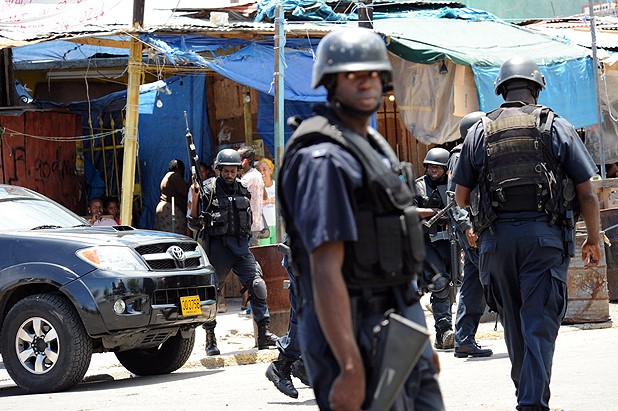AFP photo
By
Ricardo Swire
The Inter-American Development Bank’s (IDB) novel executive summary “Restoring Paradise in the Caribbean; Combating Violence with Numbers,” surmised between 2014 and 2015 thirteen percent of Bahamian, Barbadian, Jamaican, Trinidadian and Surinamese residents were victims of crime.
The IDB document analyzed national car theft, burglary, robbery, personal theft, assault or threat of assault statistics. The Bahamas, Jamaica and Trinidad & Tobago murder rates were “comparable to countries in armed conflict,” the availability of illegal guns a key factor.
The Caribbean and Latin America possess the largest pistol/revolver ownership after Africa. Despite recorded increases Barbados and Suriname maintained comparatively low homicide rates. The Bahamas’ toll was identified as the highest prevalence of crime among surveyed Caribbean members. Overall, one third of studied residents were distressed by the murder of a friend or family member. In Kingston, Jamaica half the populace felt traumatized.
Combating Violence with Numbers listed “abnormally excessive assault rates” as most common pattern among assessed territories, the Caribbean higher than any other region. Gangs were identified as main crime and violence benefactors. Residents in gang communities more likely to be victimized, especially by assaults or threats. T&T’s capital Port of Spain (POS) qualified as worst affected by crime and forceful aggression. Sixty percent of victims reported gang occupation in their neighborhoods.
Approximately one hundred and ten gangs function on T&T, with an average membership of no less than twelve. Each affiliate earns between TT$30 and TT$200 daily, commensurate with the size of gang turf and payoffs from committed crimes. The Twin Island Republic confronts this delinquency with Trinidad & Tobago Police Service (TTPS) “smart” policing techniques, guided by University of Cambridge in the United Kingdom (UK). T&T’s adaptations included high risk community patrols during trouble hours. Violence decreased by forty-four percent in targeted districts.
Globally, more than US$100 billion is spent yearly on policing the war on drugs. The IDB’s Combating Violence with Numbers analysts specified most Caribbean governments “have not applied appropriate balance between prevention and control” of crime and violence. On the five surveyed islands law enforcement’s financial expenditures were disproportionate. For every dollar disbursed, on reactive crime fighting, only two cents were spent on prevention.
Ricardo Swire
Ricardo Swire is the Principal Consultant at R-L-H Security Consultants & Business Support Services and writes on a number of important issues.



No Comments Yet!
You can be first to comment this post!